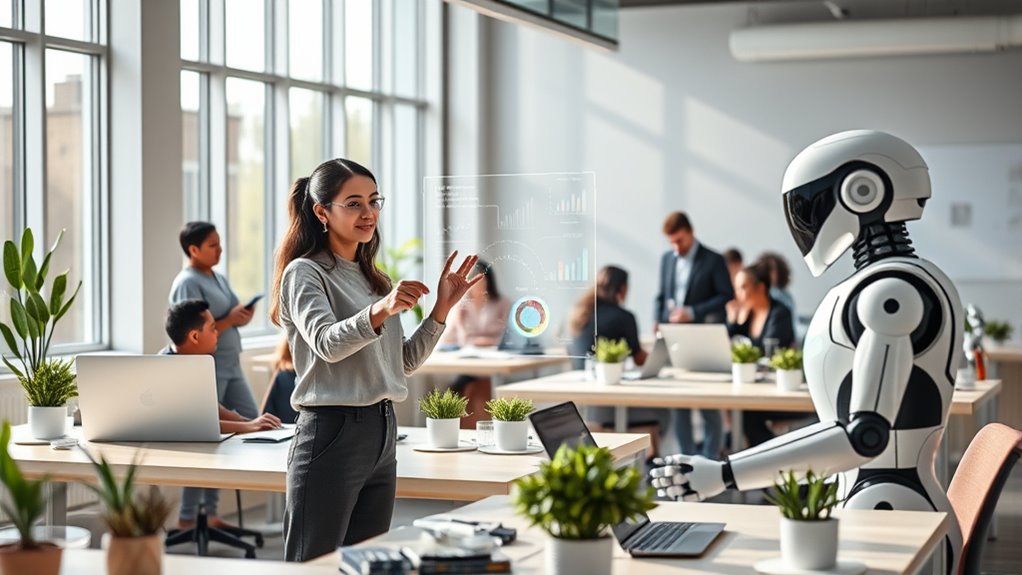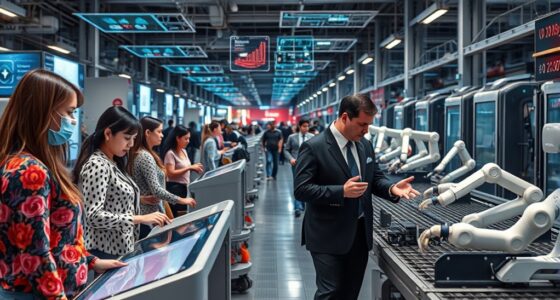Human-AI collaborations are transforming workplaces by blending bots and people to boost creativity, solve complex problems, and improve workflows. Success stories include radiologists teaming with AI to analyze scans faster and doctors using AI insights for personalized treatments. Leaders focus on building trust through transparency and bias mitigation, while teams continually adapt skills. As these hybrid efforts evolve, you’ll discover how organizations are thriving with human-AI partnerships and the lessons that can help you succeed.
Key Takeaways
- AI assists radiologists in analyzing scans quickly, reducing errors and enhancing diagnostic accuracy.
- IBM Watson supports oncologists with personalized cancer treatment plans based on genomic data.
- Emergency rooms utilize AI triage systems for faster patient assessment and better resource allocation.
- Human-AI partnerships streamline workflows in retail, finance, and IT, boosting efficiency and reducing costs.
- Collaborative AI tools foster creativity and problem-solving, generating innovative ideas and narrowing skill gaps.
Real-World Success Stories of Human-AI Partnerships

Real-world success stories demonstrate how human-AI partnerships improve outcomes across various industries. In healthcare, AI helps radiologists analyze MRI scans quickly, highlighting abnormalities and reducing errors caused by fatigue. Oncologists use AI systems like IBM Watson to craft targeted cancer treatments based on genomic data, improving personalized care. Emergency rooms benefit from AI-assisted triage, enabling faster patient assessment and intervention. In retail, AI predicts demand patterns, optimizing inventory and reducing waste, while automating routine tasks empowers employees to focus on strategic decisions. Human recruiters leverage AI to streamline candidate matching, enhancing hiring efficiency. Customer service teams use AI-powered search tools to access internal knowledge swiftly, improving response times. Additionally, machine learning algorithms continue to advance, enabling AI systems to adapt and improve performance over time. These examples show that collaboration between humans and AI leads to better accuracy, efficiency, and personalized outcomes.
Transformative Workflow Innovations Driven by AI
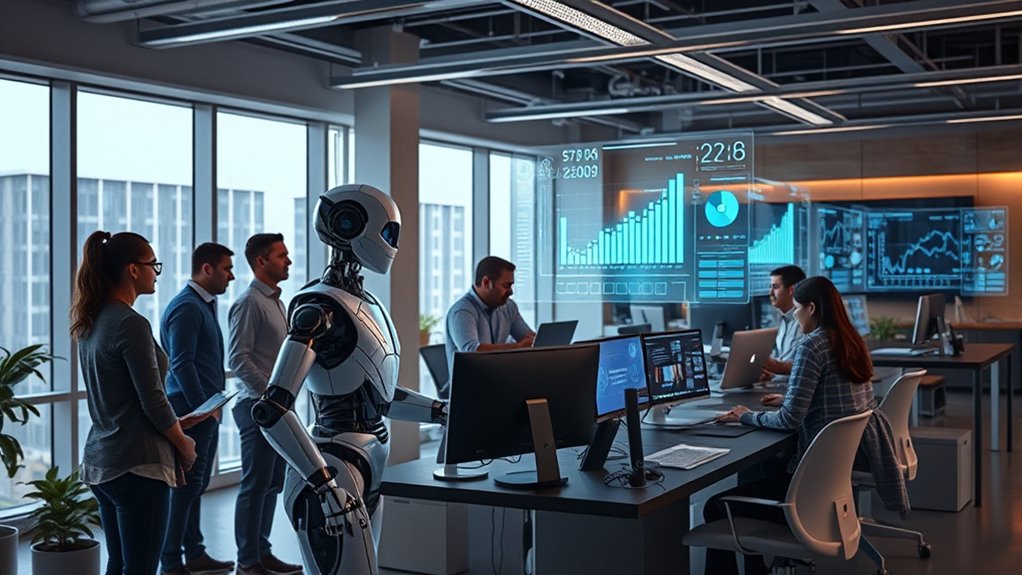
Advancements in AI are revolutionizing workflows across industries, making automation a cornerstone of digital transformation. You’ll find organizations adopting business process management tools, with 36% already automating internal workflows. Nearly half plan to automate more manual tasks soon, especially in finance and IT, reducing costs and errors markedly. Automation markets are projected to reach billions by 2025 and 2030, fueling innovation. Glycolic acid, known for its exfoliating properties, is also being integrated into skincare routines to complement these technological advances.
Enhancing Creativity and Problem-Solving With Bots

By working alongside AI bots, you can substantially boost your creativity and problem-solving abilities. AI excels at generating a wide range of ideas, acting as a powerful co-creator to inspire your work. In creative writing, AI integration can increase novelty by around 8%, helping you develop fresh story ideas. It also narrows the skill gap, offering suggestions that elevate less experienced writers to higher levels. You often use AI to fill gaps and maintain momentum, turning routine tasks into opportunities for innovation. Human-AI collaboration produces higher-quality solutions, rated better in strategic, environmental, and financial aspects. It speeds up processes and cuts costs, delivering implementable ideas with tangible value. Overall, AI amplifies your creativity and enhances problem-solving, opening new possibilities across various fields. AI’s superior idea generation and originality make it a valuable partner in creative endeavors.
Overcoming Biases: Building Trust in Human-AI Teams

Building trust in human-AI teams requires you to recognize your own biases and understand how they influence your perceptions of AI suggestions. Addressing skepticism about algorithmic decisions involves transparent communication about AI limitations and reasoning. Strategies like clear explanations and ongoing trust calibration help you rely appropriately on AI, reducing biases and fostering effective collaboration. Being aware of the trust development process can further enhance your confidence in AI systems over time. Additionally, understanding the importance of privacy policies and how they protect user data can strengthen trust in AI-driven interactions.
Recognizing Human Biases
Recognizing human biases in AI systems is essential for ensuring fairness and fostering trust in human-AI collaboration. Human biases, often rooted in systemic and historical inequalities, can unintentionally embed themselves into AI through data collection and decision-making processes. To detect these biases, bias auditing tools use fairness metrics, counterfactual and sensitivity analyses, and transparency measures. These methods help identify when human influence skews AI predictions, especially through proxy variables like healthcare costs that reflect entrenched disparities. Additionally, understanding the influence of Private Placement Equity Markets can inform how investment biases might subtly impact AI systems used in financial decision-making. However, auditing alone isn’t enough; it’s vital to involve diverse perspectives and implement longitudinal bias surveillance. Research shows that ongoing bias monitoring can reveal how biases evolve over time, enabling proactive adjustments. By actively recognizing and addressing human biases, you can improve AI fairness, increase transparency, and build confidence in AI-human partnerships—ultimately leading to more equitable and trustworthy outcomes.
Addressing Algorithmic Skepticism
Addressing algorithmic skepticism is essential for establishing trust between humans and AI systems, especially when biases threaten to undermine confidence. You need transparent, fair, and reliable AI to feel secure in your interactions. To build this trust:
- Prioritize data quality: Ensure diverse, balanced datasets to reduce biases that distort AI decisions. High-quality data minimizes errors and hallucinations, leading to more accurate outputs. Incorporating inspirational quotes about fatherhood can also foster positive perceptions of AI-human collaboration by emphasizing shared values of guidance and support.
- Implement fairness techniques: Use metrics like F1 scores and include protected attributes during training to promote fairness.
- Enhance transparency: Share clear explanations of AI processes without revealing sensitive details, helping you understand and trust the system.
Fostering Trust Strategies
How can teams foster trust amidst the complexities of human-AI collaboration? Start by enhancing transparency and communication. Clear channels between developers and users are essential; accessible documentation helps you understand AI functions, while sharing AI uncertainties and limitations builds confidence. Effective communication includes two-way exchanges, allowing you and the AI to adjust trust based on ongoing assessments. In autonomous systems, transparent intentions enable you to maintain awareness and trust calibration. Design user interfaces that prioritize ease of use, fostering positive interactions and reducing misunderstandings. Recognize AI’s strengths, like data analysis, alongside human skills such as creativity, promoting mutual respect. Finally, encourage continuous learning through feedback, helping AI improve and adapt while you develop new skills, strengthening long-term trust and collaboration. Incorporating herbal tea benefits into team routines can also promote relaxation and reduce stress, fostering a more positive environment for trust-building.
Case Studies of Hybrid Workforces in Action

Have you ever wondered how organizations seamlessly blend human expertise with AI capabilities to boost productivity and innovation? In healthcare, this synergy transforms patient care. For example:
- IBM Watson Health analyzes vast medical data, helping doctors make more accurate diagnoses and deliver personalized treatments.
- AI diagnostic support systems assist physicians in recognizing diseases through pattern recognition, ensuring human judgment remains central.
- AI-driven insights present findings clearly, highlighting concerns and guiding decision-making, while systems continuously learn from provider feedback.
- This collaborative approach leverages AI’s ability to process complex data rapidly, freeing healthcare professionals to focus on patient interaction and complex decision-making.
- The ongoing feedback loop between humans and AI ensures continuous improvement and adaptation to new medical challenges.
These hybrid approaches foster proactive, tailored medicine and improve outcomes. The collaboration isn’t static; it evolves with ongoing feedback, making healthcare more efficient, precise, and compassionate. Together, humans and AI are reshaping the future of medicine.
Skill Development for Effective Collaboration
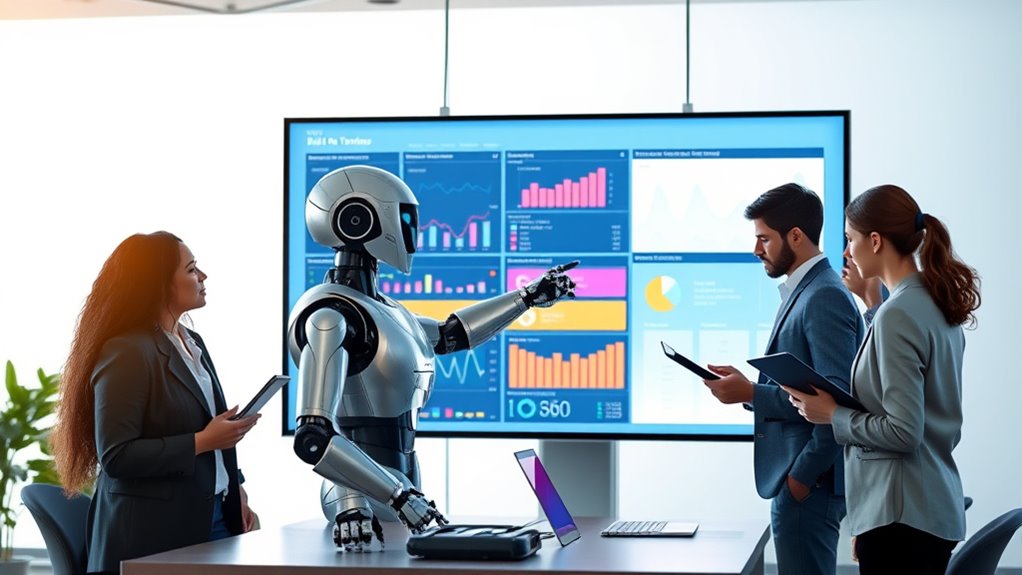
As organizations harness the power of human-AI collaboration, developing the right skills becomes essential to maximize effectiveness. You need to identify and measure skills that focus on real-world application, proficiency, and continuous growth. Soft skills like communication and problem-solving are now quantifiable, boosting your ability to work alongside AI. Clearly defining roles helps optimize collaboration, while spotting skill gaps allows targeted upskilling. The table below highlights core skills for success:
| Skill Area | Focus | Outcome |
|---|---|---|
| Technical Skills | AI tools, data literacy, prompt engineering | Better interaction and efficiency |
| Human Skills | Leadership, communication, adaptability | Strong oversight and teamwork |
| Growth & Development | Continuous learning, upskilling, change management | Sustained collaboration success |
To stay ahead in this evolving landscape, organizations must also continually assess and update skill sets to match emerging AI capabilities, ensuring that both human and AI contributions remain aligned with strategic goals. Developing targeted training programs helps close skill gaps and fosters a culture of continuous improvement, which is vital in a rapidly changing technological environment.
Leadership Strategies for Managing AI-Integrated Teams

Effective management of AI-integrated teams requires strong leadership that clearly articulates vision, fosters collaboration, and guides change. When leaders set a clear AI strategy, employee engagement rises to 62%, and teams work better together, with 83% reporting strong collaboration. As a leader, your role is to create a culture where 79% see AI as a positive influence. To succeed: 1. Inspire confidence by communicating a compelling AI vision, reducing uncertainty and building trust. 2. Promote inclusivity and adaptability, encouraging teams to embrace ongoing change. 3. Support continuous learning, focusing on uniquely human skills like empathy and strategic thinking, which AI can’t replace. AI adoption varies widely, with 31% of organizations lacking a formal strategy, highlighting the importance of proactive leadership. Strong leadership drives AI success, transforms workplace culture, and keeps your team motivated amid rapid technological shifts. In addition, providing ongoing training that emphasizes professional development helps teams stay current and confident in their evolving roles.
Ethical Considerations in Human-AI Interactions

You need to recognize that bias mitigation strategies are vital to prevent unfair outcomes in AI systems. Ensuring transparency standards helps you understand how decisions are made and builds trust. Addressing both points is crucial for ethical and effective human-AI interactions. Fundamental ethical principles, such as fairness and transparency, guide the responsible development and deployment of AI technologies.
Bias Mitigation Strategies
Bias mitigation strategies are essential to ensuring ethical human-AI interactions because they help prevent algorithms from perpetuating stereotypes and unfair treatment. You must focus on collecting diverse, representative data to reflect real-world demographics, continuously auditing datasets to remove outdated or biased information, and following strict ethical standards to protect privacy. Additionally, incorporating human-in-the-loop systems allows you to catch biases early, with trained reviewers providing oversight and feedback. Engaging a multidisciplinary group—including ethicists, sociologists, and community voices—ensures broader perspectives shape fairer AI. Finally, designing algorithms that prioritize fairness through bias correction, evaluating their impact across groups, and investing in ongoing research will help create systems that serve everyone justly. These strategies are crucial to fostering trustworthy, responsible AI-human collaboration. Implementing robust governance measures ensures that these bias mitigation efforts are systematically monitored and maintained over time.
Ensuring Transparency Standards
How can organizations guarantee that their AI systems remain transparent and trustworthy? By implementing clear explainability, so users understand how decisions are made, and interpretability, making internal processes accessible to non-experts. Establishing accountability involves defining responsibility for AI-driven outcomes, and communication clarity ensures data collection and usage are openly shared. Prioritize user consent and privacy, clearly stating policies before data collection. Practical measures include disclosing training data, explaining bias mitigation efforts, maintaining audit trails for decisions, and providing detailed explanations for AI recommendations. As AI evolves, focus on dynamic trust calibration, communicating uncertainty, sharing knowledge gaps, and integrating physiological feedback. Overcoming technological barriers and adapting transparency to cultural and regulatory contexts are essential to uphold ethical standards and foster trust in human-AI collaborations. Effective transparency is also critical for complying with emerging regulations like the EU Artificial Intelligence Act, which emphasizes responsible AI practices.
Future Trends in Human-AI Co-Working Environments
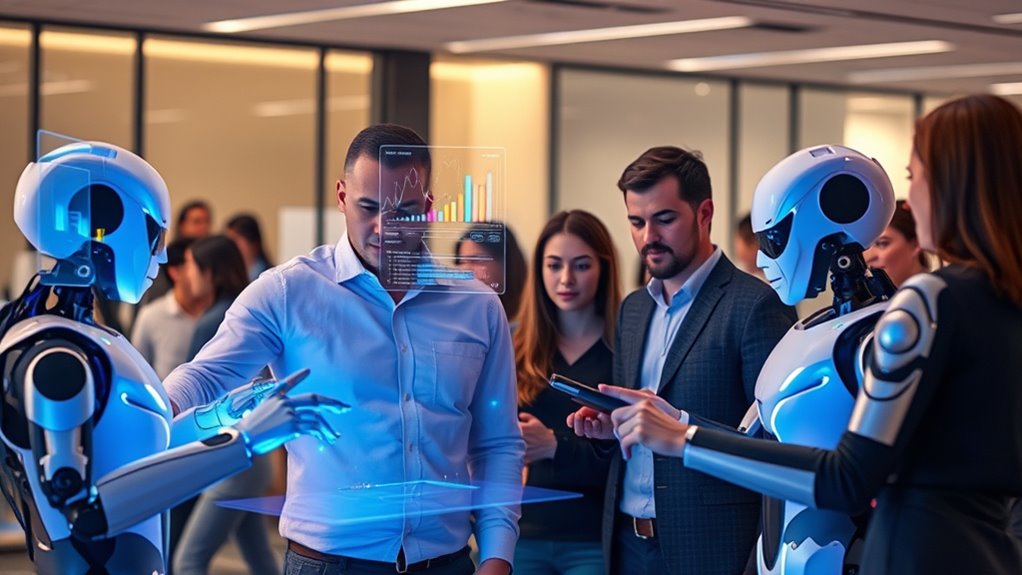
Future trends in human-AI co-working environments point toward increasingly autonomous and intelligent systems that collaborate seamlessly with human workers. You’ll see AI agents evolving beyond simple tools to independent entities managing complex workflows like reporting, logistics, and customer service. These agents will learn and adapt without your intervention, boosting productivity and reducing manual tasks. Human‑Centric AI integration will ensure these systems complement and enhance human roles rather than replace them.
- Autonomous AI agents will handle routine and complex tasks, freeing you to focus on strategic work.
- Hyper-personalized digital personas will offer tailored support, strengthening your relationship with AI tools.
- Multi-agent collaboration and self-healing systems will enhance efficiency, prevent downtime, and optimize operations.
Together, these trends will reshape workplaces, making human-AI collaboration more intuitive, efficient, and impactful.
Lessons Learned From Thriving Human-Ai Collaborations

Thriving human-AI collaborations reveal valuable lessons about maximizing the strengths of both parties. You learn that AI enhances decision-making by increasing accuracy and reducing errors, especially in high-stakes fields like healthcare. When AI analyzes large datasets, it helps identify risks and suggests personalized treatment plans, boosting confidence and efficiency for professionals. Additionally, AI improves emotional and creative collaboration by supporting mental health conversations and artistic processes, enhancing empathy and innovation. Response time and error rates drop as AI tracks inputs and offers second opinions, allowing humans to focus on complex judgments. Personalization is key—AI adapts to individual needs, providing tailored assistance and improving satisfaction. Leveraging AI’s data-processing power, these lessons highlight that successful collaboration depends on leveraging AI’s analytical power while preserving human intuition and creativity.
Frequently Asked Questions
How Do Organizations Measure AI and Human Skill Integration Effectively?
You measure AI and human skill integration effectively by tracking key performance indicators like task success rate, which shows how well tasks get completed accurately. You also monitor time reduction to gauge efficiency. Additionally, assess AI output accuracy, team satisfaction, and overall system accuracy. These metrics help you understand collaboration quality, identify improvement areas, and ensure AI complements human efforts seamlessly for ideal performance.
What Strategies Ensure Ethical AI Deployment in Collaborative Settings?
They say, “Trust, but verify.” To guarantee ethical AI deployment in collaborative settings, you should establish clear policies on fairness and privacy, involve diverse stakeholders in guideline creation, and maintain transparency and accountability. Conduct regular risk assessments and bias detection, implement robust data governance, and foster ongoing monitoring. Promote human oversight and develop collaboration tools, ensuring continuous feedback and adaptation to evolving ethical standards, so both humans and AI thrive together ethically.
How Can Biases Be Identified and Mitigated in Human-Ai Teams?
You can identify biases in human-AI teams by using bias auditing tools, fairness metrics, and transparency features. To mitigate them, design tailored strategies that address both human and AI biases, incorporating diverse perspectives and organizational policies. Continuously evaluate your approaches through empirical testing and feedback loops, recognizing interaction effects. Combining technological solutions with organizational efforts helps reduce biases, ensuring fairer, more effective collaboration between humans and AI systems.
What Are the Best Practices for Training Humans to Work With AI?
You should focus on providing clear training that emphasizes AI’s capabilities, limitations, and appropriate usage. Encourage curiosity and ongoing learning through hands-on practice and feedback. Teach you to identify when AI is most effective, and when human judgment is essential. Foster collaboration skills, emphasizing complementary strengths, and promote a culture of continuous improvement. Regularly update training to reflect evolving AI tools, ensuring you adapt seamlessly and work confidently alongside automation.
How Will Leadership Roles Evolve With Increased Human-Ai Collaboration?
You might think leadership stays the same, but with AI in the mix, it’s anything but. You’ll become a hybrid thinker, blending human intuition with machine insights, while automating routine tasks. Your role shifts to guiding autonomous systems, fostering innovation, and making strategic, data-driven decisions. Ironically, your biggest challenge becomes balancing ethical considerations and preserving human strengths like empathy—proving leaders aren’t obsolete, just smarter and more adaptable.
Conclusion
As you embrace human-AI collaboration, remember that together, you forge a future brighter than any machine alone. Like a symphony where each instrument plays its part, your partnership creates harmony from diversity. Trust, innovation, and ethical choices will guide you through challenges. So, step forward boldly—because when humans and AI thrive side by side, you unleash possibilities that can change the world. The future is waiting, and it’s yours to shape.
